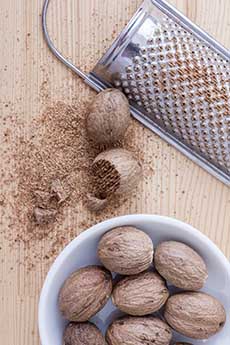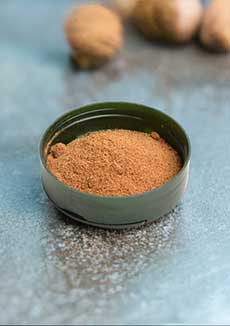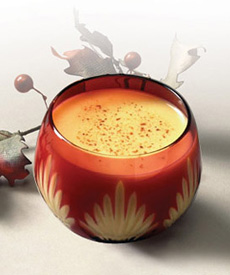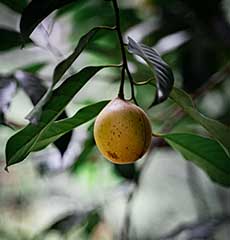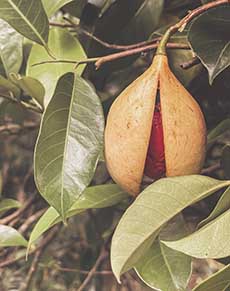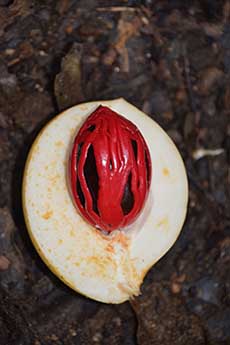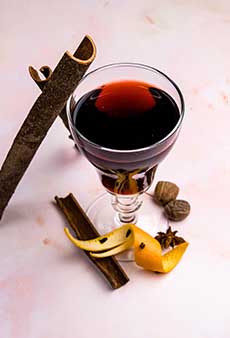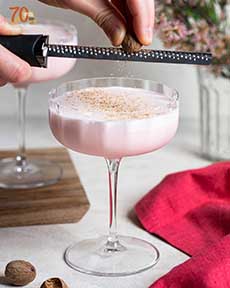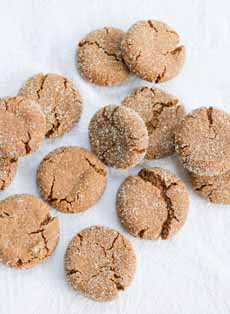Beyond The Holidays: Uses For Nutmeg & Nutmeg History
|
Nutmeg is one of the so-called warm or sweet spices, delivering a subtle blend of sweet and spicy notes. Nutmeg grows on trees but it’s not a tree nut. Rather, it’s the seed of a fruit of an evergreen tree. If you have a nut allergy, fear not. While it’s a year-round asset in your kitchen, here’s why many people pull out nutmeg for the holiday season. Below: > Below: Different uses for nutmeg. > Below: The history of nutmeg. Nutmeg is often associated with the Christmas holidays because it’s used in many traditional holiday recipes. During the holiday season, Europeans traditionally have used nutmeg in recipes for foods such as eggnog, pumpkin** pie, gingerbread cookies, and various other desserts—and savory dishes, too, such as nutmeg sausage. The spice’s rich and earthy flavor and fragrant aroma add depth to these dishes and contribute to the overall festive atmosphere of Christmas. One reason that most people reserved nutmeg for the holidays was the expense*** of the spice, before its wide availability in the 19th century. Most spices were once considered luxury items and were associated with special occasions and celebrations. As a result, the tradition of using spices like nutmeg in holiday recipes has been passed down through many generations. Nutmeg is used in cuisines worldwide, adding flavor to both sweet and savory dishes with its warm, sweet, and slightly nutty flavor. Here are some common uses for nutmeg: Medicinally, nutmeg is known as an anti-inflammatory and anti-thrombotic, and has anti-rheumatic, carminative (relieving flatulence), and stimulant properties. In pregnancy and lactation, nutmeg is used in traditional medical practice for antenatal and postnatal treatment [source]. Nutmeg also yields an oil known as nutmeg butter. This creamy yellow butter is semi-solid and is used in many balms. It’s thought to soothe joint pain, elevate mood, and even treat the symptoms of colds. Plus, thanks to its delicious scent, nutmeg is often found in beauty products—moisturizers, perfumes, and soaps—and dental products. For millennia, the only people who knew about nutmeg were the residents of Indonesia, where the spice originated. Nutmeg is spice that comes from the fruit of the Myristica fragrans evergreen tree (photos #4 and #5), native to the Moluccas, or Spice Islands, in Indonesia. Nutmeg is not a nut: It is the seed of a fruit the size of an apricot (photo #6). The fruit, which is edible, has a single, large seed. This type of fruit is botanically known as a drupe (as are apricots and other stone fruits). The name nutmeg is derived from the Latin nux muscatus, meaning “musky nut.” The spice has long been highly prized for its aromatic and flavorful properties and has played a significant role in the global spice trade. The earliest evidence of the use of nutmeg comes in the form of 3,500-year-old potsherd residues from the island of Pulau Ai, one of the Banda Islands in eastern Indonesia. These islands were the only source of nutmeg and mace production until the mid-19th century [source]. The ancient Romans are believed to have known about nutmeg. Around the first century, C.E., the Roman author Pliny wrote of a tree that bore nuts with two flavors—presumably mace and nutmeg. In the sixth century C.E., nutmeg use spread from Indonesia to India, then further west to Constantinople (modern Istanbul, Turkey). By the 13th century, Arab traders had discovered the origin of nutmeg but kept the location a secret from European traders. They introduced the precious spice to the West, bringing it to the Middle East and Europe. During the Middle Ages, nutmeg was prized in Europe for use in medicine and as a preserving agent. Wealthy nobles (or rather, their servants) used nutmeg graters to grind up the spice and add it to alcoholic drinks to show off their affluence [source]. Nutmeg played a crucial role in the colonial expansion of European powers. It was highly sought after for both culinary and medicinal purposes. The demand for nutmeg and other spices drove European exploration and colonization efforts. Christopher Columbus was trying to find a route to the Spice Islands when he discovered the Americas instead [source]. In the 15th century, the Banda Islands were facing invasion by the Portuguese. Explorers were sent on an expedition in 1512 by commander Albuquerque of the Portuguese fleet stationed in Malacca, Malaysia, to get the spice denied to them by the Turks. The fleet’s mission was to locate the so-called “spice island.” Locate they did, that same year, and the commander of the boats, Francisco Serrao, became the first European to gather nutmeg and cloves from the archipelago. At this point, the Portuguese gained control of the islands. Their reign made nutmeg more affordable and available in Europe—at least until the Dutch ousted them in the early 17th century. In the 16th century, the Portuguese expelled the Arabs and gained control over the Spice Islands trade. By the early 17th century, the Dutch managed to gain a monopoly over the nutmeg trade, establishing control over the Banda islands. They destroyed nutmeg trees on other islands to limit production and create a lucrative spice monopoly. They defended their monopoly fiercely, starting a brutal war. In 1621, they began to massacre and enslave many of the Banda natives. The Dutch ruled with an iron fist, destroying plantations and creating strict laws that were enforced by the death penalty. Then the English arrived. The English and the Dutch East India Company engaged in conflicts over control of the Spice Islands. It ended when the two countries signed the Treaty of Breda in 1667. Among other things, the Dutch handed over control of New Amsterdam (New York City) to the British in exchange for the Dutch retaining control of the nutmeg-producing Banda Islands. The Dutch held control of the islands for another hundred years or so. But in the 18th century, the French managed to smuggle nutmeg plants out of the Spice Islands. During the Napoleonic Wars, French spice traders smuggled nutmeg trees out of Banda and over to Zanzibar, an island in the Indian Ocean off the coast of east-central Africa, and the Caribbean island of Grenada. Thus commenced the downfall of the Dutch nutmeg monopoly and the affordability of nutmeg to consumers worldwide. Today, Indonesia remains the largest producer of nutmeg, with Grenada a significant producer of nutmeg—so much so that it has been nicknamed “The Isle of Spice” and the country’s flag bears a nutmeg. Other significant producers include India and Sri Lanka. Nutmeg continues to be a popular and versatile spice in kitchens worldwide: in Indonesia, India, the Middle East (it’s an ingredient in the spice blend ras el hanout), Grenada and other Caribbean islands, European (France, Italy, and the Netherlands, the U.S., North Africa (particularly in Morocco and Tunisia, Malaysia and Singapore. **Pumpkins and other squash were brought to Europe from Central America at the turn of the 16th century. |
|
|
|
***In the 17th century, the monopoly on the spice caused it to be worth more by weight than gold. The contemporary 1.5-ounce bottle of nutmeg you have in your kitchen would be worth $2,800.00 at today’s prices [source]. †Mace is the spice made from the reddish seed covering (the aril) of the nutmeg seed. Its flavor is similar to nutmeg but more delicate. It is used to flavor baked goods, fish, meat, and vegetables, and in preserving and pickling. In the processing of mace, the crimson-colored aril is removed from the nutmeg seed that it envelops and is flattened out and dried for 10 to 14 days. Its color then changes to pale yellow, orange, or tan. ‡The sweet spices include allspice, cardamom, cinnamon, mace, and nutmeg. CHECK OUT WHAT’S HAPPENING ON OUR HOME PAGE, THENIBBLE.COM.
|
||
